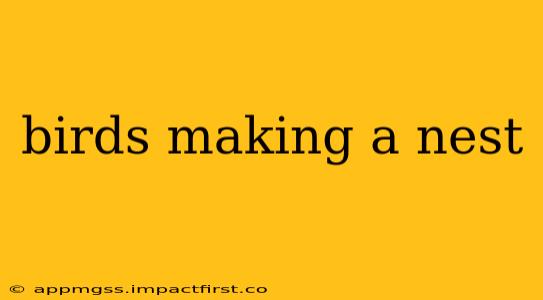Birds' nests are marvels of natural engineering, each a testament to the ingenuity and instinct of the avian world. From the humble cup-shaped nest of a robin to the intricately woven pendulous nests of some weaverbirds, the diversity is astounding. But what exactly goes into building a nest? Let's explore the fascinating world of avian architecture.
What materials do birds use to build their nests?
The materials used vary greatly depending on the species and the environment. Common materials include twigs, leaves, grasses, moss, mud, spider silk, feathers, lichen, and even human-made materials like string, yarn, and plastic. Some birds, like swallows, incorporate mud to create a sturdy cup, while others, like orioles, use plant fibers to weave elaborate hanging nests. The availability of resources heavily influences the nest's construction. For example, a bird living in a forest will likely use more twigs and leaves, whereas a bird near a human settlement might incorporate discarded materials.
How do birds choose a nest location?
Nest site selection is crucial for survival. Birds prioritize safety and accessibility to resources. Common considerations include:
- Protection from predators: Nests are often hidden within dense foliage, tree hollows, or rock crevices to protect eggs and chicks from predators.
- Accessibility to food: Nests are typically built near a reliable food source to minimize parental foraging trips.
- Structural stability: The chosen location must provide a stable platform for building and supporting the nest's weight.
- Weather protection: The nest needs to offer shelter from rain, wind, and extreme temperatures.
Different species have different preferences. Some birds prefer to build nests high in trees, while others prefer lower branches or even ground nests.
How long does it take a bird to build a nest?
The time it takes to construct a nest varies significantly depending on the species and the complexity of the nest. Some simple nests can be built in a few days, while more complex structures might take several weeks. The female typically does most of the nest building, although the male may assist in collecting materials or in some cases, does the bulk of the construction.
What is the purpose of a bird's nest?
The primary purpose of a bird's nest is to provide a safe and protected environment for eggs and chicks. It offers:
- Protection from the elements: The nest shelters eggs and chicks from rain, wind, and extreme temperatures.
- Camouflage: Many nests are designed to blend in with their surroundings to avoid detection by predators.
- Support for eggs and chicks: The nest provides a secure platform for the eggs and a stable place for the chicks to rest and grow.
- Insulation: Many nests offer insulation to regulate temperature and keep the chicks warm.
Do all birds build nests?
No, not all birds build nests. Some species, like the brown cuckoo, are brood parasites and lay their eggs in the nests of other birds. Others, like certain seabirds, simply lay their eggs on the ground or on bare rock surfaces. However, the vast majority of birds do construct nests.
Why are some bird nests more elaborate than others?
The complexity of a bird's nest is often related to its nesting habits and the environment it inhabits. Birds that are more vulnerable to predation tend to build more concealed or well-protected nests. Birds living in exposed environments might construct sturdier nests to withstand the elements. The evolutionary pressures of survival have shaped the diverse range of nest designs we observe today.
This exploration only scratches the surface of the fascinating world of bird nest building. The intricate details and species-specific variations make each nest a unique work of art and a testament to the remarkable adaptability and intelligence of birds.
